|
|
|||||
| home > architetture | |||||
| NL
ARCHITECTS. NL Lounge |
|||||
| WELCOME.
For the first time in the history of the Biennale the Organization does
not take the responsibility any longer for the surveillance system of
the individual pavilions. In the year 2000 the participating countries
take over supervision. This logistical detail is a manifestation of
a global tendency towards privatization. The space formerly-known-as-public
more and more becomes exclusive and discriminatory. |
[10mar2004] | ||||
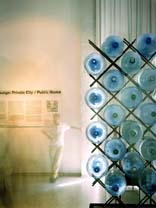
|
 MEMBERS ONLY. In the Dutch entry this becomes tangible by means of a selective entrance protocol for the pavilion. In order to avoid the semi-hysteric, run-shopping aspects of a big fair like the Biennale and to create a more relaxed and steady environment, the public is filtered. A doorman selects the crowd. Once you're inside you are kindly requested to take off your shoes (for that homey feeling) and thus become part of a defined group. The traditional gauge for refusal is inappropriate footwear, but since the pavilion is to be accessed barefooted what new criterion will be laid down? LOUNGE. The pavilion offers a place to unwind from the frantic conditions of the expo, to meet people, to hang out, to chill: a lounge. Within this collective field the main asset of the NL Lounge is the possibility of individual appropriation; customization of light, audio, climate, input and output. You'll find so called Auping beds transforming into lounge chairs at your command, searchlights that are individually controlled, monitors that show whatever you want to see. If the Internet defines every user as a target group what are the possibilities of this notion for architecture and planning? |
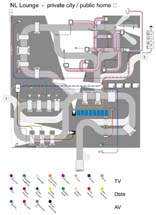 
|
|||
 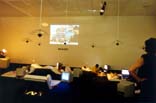
|
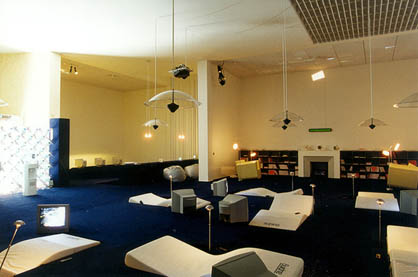 SOUND SHOWER. The Sound Focussing Speaker System is the invention that brings relaxation in the cacophony that this collection of free choices traditionally would result in: an end-eighties-media-bombardment of indistinguishable audio, in white noise. The 'Sound Shower' has the unique and groundbreaking capacity to unravel multiple output into understandable info, to turn public space into private. Invisible borders define perfectly directed, intimate acoustic territories: serenity. MONO-MEDIA. The convergence of technology and body is accelerating. In order for the World to become an inseparable, fundamental part of the pavilion and the individual a network of cables and wires has to penetrate into the pavilion. A new type 'computer floor' absorbs this net. Sculptural modifications allow for integration of technique and comfort zones. The pavilion eliminates the boundaries between programs in the way we knew them. A continuous library-bar-furniture-shop-book-store-livingroom-workstation-lobby-square comes into existence. |
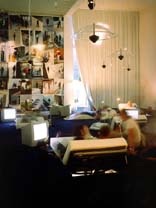
|
|||
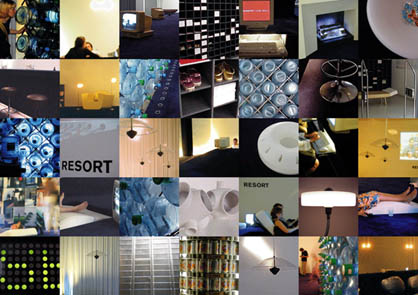 MUSEUM 2K+. The Dutch pavilion, designed in 1953 by Gerrit Rietveld, is the ultimate display for modern art. The building is in plan a swastika-like structure measuring 16 times 16 meters and 6 meters high. Three cross walls, 4 meters long, differentiate the larger whole into smaller areas and create intimacies. After Willem Sandberg, the most influential curator of the last century in the Netherlands, visited the pavilion in 1954, he wrote: dear Riet, this morning we were in your pavilion: it's perfect - you made a small space great. It's the most beautiful space I know. Filtered, natural light illuminates the room. But for multimedia presentations and time-based arts the divine light becomes an obstacle. For this type of installation the pavilion had to be freed from its most elaborated quality. A certain degree of darkness is necessary. Museums of contemporary art need to resolve the dilemma: to become totally individualized/autistic or to establish a forum for communication. How to create a darkroom that doesn't revolve around sexual interaction only? |
|||||
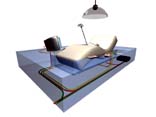
|
BIG
BROTHER. In the Lounge you can be the online-witness of the operations
and the in and outs of an architecture firm somewhere in Holland. Is
Jennifer in time? What is Niels wearing today? Did Pieter stop smoking
already? How did the model turn out? Are the panels in time? Was the
client happy? This voluntary exposure creates a consciousness of the
monitored condition we are living in: Surveillance cameras, biometric
access passes, fingerprint readers, facial features recognition, access
codes, x-ray, scanners, infrared detection, iris identification, data
logger, bonus cards, pin code, credit card. What consequences could
the shift in the notion of privacy, the loss of anonymity, have for
architecture? 1:1. The NL Lounge responds to this year's theme by purging representational elements (models, drawings and so on) from what is exhibited. The installation does not mimic the contemporary condition but seeks to be a fundamental part of it. It presents 'the process' at any level. The pavilion attempts to be non-judgmental, non-moralistic and non-paternalistic but hopes to reveal and make tangible some of the developments in society today. NL Architects |
||||
|
>
NL ARCHITECTS |
|||||
|
Per
candidare progetti laboratorio
|
|||||